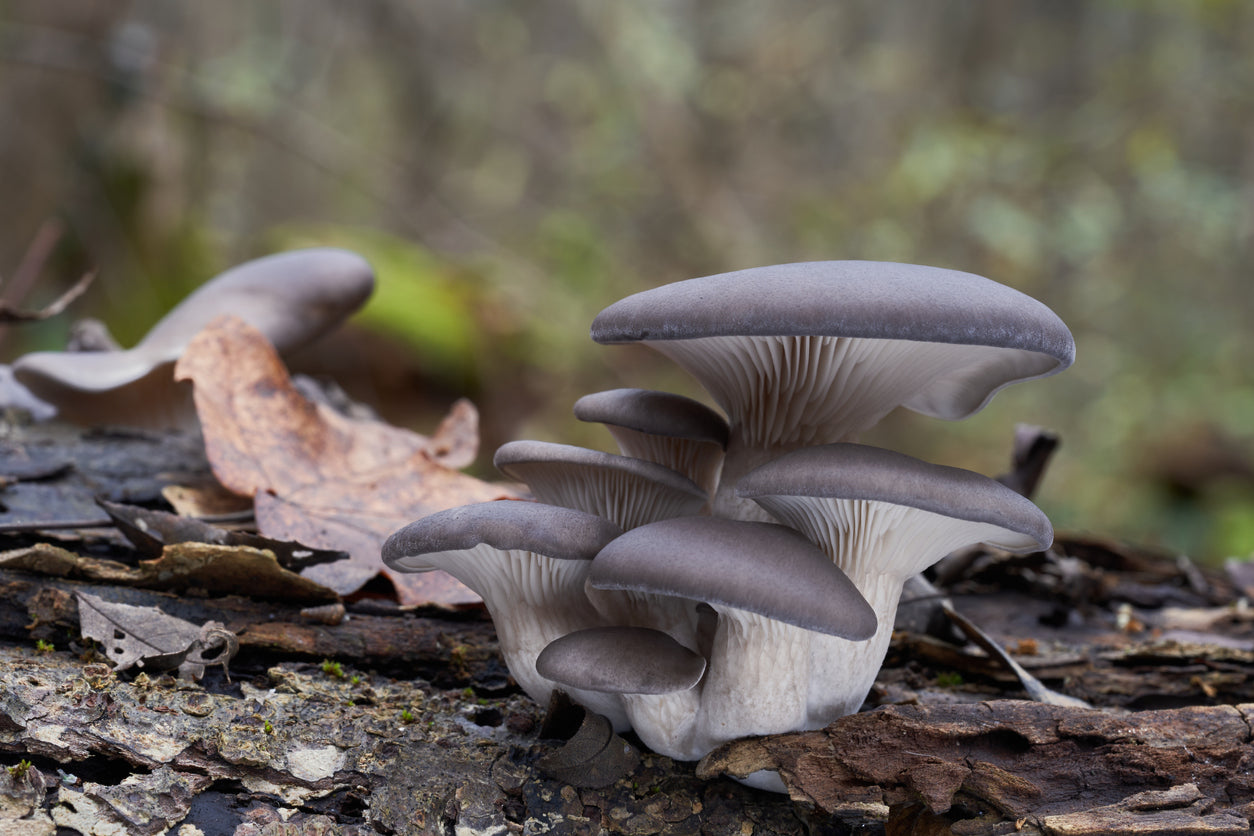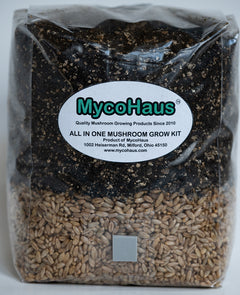Blue Oyster mushrooms (Pleurotus ostreatus var. columbinus) belong to the treasure trove of the fungi kingdom, offering a cornucopia of tastes, textures, and health benefits.
They are a marvel in both cultivation and culinary use. Here’s an in-depth look into their world.

Description and Taste
Physical Characteristics
These mushrooms grow in shelf-life structures, forming clusters that are a feast for the eyes. They showcase a dramatic size range depending on their growing conditions, from broad, flat caps to slender, elongated stems.
- Caps: When young, the caps are a vivid dark blue, transitioning to a gentler blue-grey upon maturity. They have a characteristic smooth and brittle surface, which sometimes dips slightly in the center and has wavy margins.
- Gills: Beneath each cap lies a forest of slender, white gills, which house a bounty of spores ready to propagate the species.
- Texture: Their consistency is spongy, robust, and slightly chewy, adding a unique mouthfeel to any dish they grace.
Flavor Dynamics
The Blue Oyster mushroom’s taste evolves from raw to cooked.
- Raw: Offers a metallic hint and an aroma that marries the scent of an ocean breeze with the sweetness of anise.
- Cooked: Cooking them unlocks a velvety, tender texture and a savory, earthy flavor with a backdrop of licorice.
However, it is not recommended to eat mushrooms raw. You should always thoroughly cook mushrooms to break down the cell walls so they are more easily digested.
Seasons and Availability
Blue Oyster mushrooms are a special ingredient for chefs and food lovers. They grow during spring and autumn, when the conditions are just right.
Nutritional and Health Benefits
Rich in nutrients, these mushrooms are not just tasty but also potent in health-boosting properties.
- Vitamins and Minerals: They are abundant in vitamin D, B vitamins, potassium, vitamin A, iron, copper, and riboflavin.
- Health-Enhancing Properties: The presence of chitin (thoroughly cooked) helps support gut health, and antioxidants in the mushrooms fight against oxidative stress in the body.
Cultivation and Commercial Popularity
Blue Oyster mushrooms are a darling of mushroom cultivators due to their robust nature and the ease with which they can be grown.
- Cultivation Conditions: They flourish in cooler climates and can be found on logs, stumps, and decaying hardwood.
- Commercial Use: They are a standout among the 200 subspecies of oyster mushrooms for their commercial viability, thanks to their quick growth and unique appearance.

Culinary Applications: A Versatile Delight
In the kitchen, Blue Oyster mushrooms are a chameleon, adapting to various cooking methods and pairings.
- Techniques: You can cook them by grilling, roasting, frying, or sautéing.
- Dish Pairings: Their flavor complements a medley of mushrooms, enriches broths, and can top pizzas or burgers. They blend harmoniously with herbs, vegetables, and proteins.
- Storage for Freshness: Keep them in a brown paper bag in the refrigerator to maintain their freshness. They can also be dried or frozen for long-term storage.
Ethnic Significance and Modern Use
Blue Oyster mushrooms hold a special place in Japanese cuisine, often featured in Donabe or Nabemono dishes for their seafood-like essence and vibrant color.
Historical Journey and Presence
From their origins in Europe to their documented existence in 1775, Blue Oyster mushrooms have journeyed across the globe.
They've been a source of sustenance in times of scarcity and now represent a symbol of nature's abundance and resilience.
Global Cultivation and Availability
Today, the Blue Oyster mushroom is cultivated and sold worldwide, from forests to specialty farms to digital storefronts, making them accessible to everyone, from the home cook to the professional chef.
In essence, Blue Oyster mushrooms are not merely an ingredient but an integral part of culinary diversity, health, and history.
They serve not only as a base for a variety of dishes but also stand as a testament to the connection between our diet and the natural world.
Their story, from the wild forests of Europe to the kitchens around the globe, is a journey of taste, versatility, and wellness worth exploring by any mushroom aficionado or culinary enthusiast.
FAQ
When should I harvest blue oyster mushrooms?
Blue Oyster mushrooms should be harvested when their caps are still slightly curled downward. This usually occurs within about 3 to 7 days after the mushrooms begin to form.
Harvest before the edges of the caps uncurl completely and become flat or inverted, which is a sign of overmaturity.
Are blue oyster mushrooms psychedelic?
No, Blue Oyster mushrooms are not psychedelic. They do not contain psilocybin or other psychoactive substances found in some other mushroom species. They are purely culinary mushrooms valued for their flavor and texture.
Can you eat blue oyster mushrooms raw?
While Blue Oyster mushrooms can be consumed raw, it is not recommended. Their flavor is much more pronounced when cooked, and they are easier to digest.
They may have a slightly metallic taste when raw, which cooking can mellow out, enhancing their savory taste and tender texture. Learn how to cook blue oyster mushrooms here.
Can you use blue oyster liquid culture?
Yes, you can use blue oyster mushroom liquid culture to cultivate Blue Oyster mushrooms. Liquid culture contains the mycelium of the mushroom in a nutrient-rich liquid and can be used to inoculate substrates to grow mushrooms.
It's a popular method for mushroom cultivation due to its ease of use and ability to produce a large number of mushrooms from a small amount of culture.
Where can I get blue oyster grain spawn?
Blue Oyster mushroom spawn can be purchased from a variety of sources, including online retailers, specialty gardening shops, and suppliers of mushroom cultivation materials.
It's important to buy from reputable sources to ensure the quality and viability of the spawn when growing blue oyster mushrooms. You can also find high-quality blue oyster mushroom grow kits.
Remember that when cultivating mushrooms, maintaining a sterile environment and following proper inoculation and cultivation techniques are crucial for a successful yield.



Leave a comment